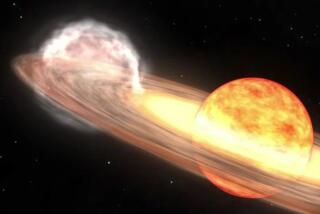Supernova Sparks Search for New Clues to Universe
- Share via
BERKELEY — Astronomers trained their high-tech telescopes on a supernova blazing in the skies this week, hoping the star’s fiery death will be the source of new clues to the universe.
The exploding star, about 11 million light-years from Earth, is the brightest to be observed in the Northern Hemisphere in decades, giving scientists a rare glimpse at the inner workings of the cosmos.
“We’re trying like mad to observe this thing every night,” said Alex Filippenko of UC Berkeley, who is coordinating observations.
“There has been tremendous excitement,” concurred Brian Marsden of the Smithsonian Astrophysical Observatory in Cambridge, Mass., a clearinghouse that records astronomical discoveries.
The supernova, known as SN1993J, was discovered March 28 by Francisco Garcia Diez, an amateur astronomer in Spain. Filippenko has been monitoring observations since March 29.
In Northern California, a team watched the supernova from Leuschner Observatory, 10 miles from the Berkeley campus, and from Lick Observatory near San Jose. Filippenko is in computer contact with hundreds of other observers.
Scientists are fascinated by supernovas because they believe that the exploding stars are the source of many elements found in the universe, including oxygen. Supernovas also produce large shock waves that some scientists think are involved in the forming of stars.
“You only see a dot of light, but it’s the study of that dot of light over the entire electromagnetic spectrum that tells us something about the explosion, about what the star’s doing and what kind of chemical elements it synthesizes,” Filippenko said.
At Lick, Stan E. Woosley, a UC astrophysicist, was waiting to see what the supernova would reveal. So far, X-rays have been detected and the supernova, which started to fade last week, brightened a little.
The last very bright supernova observed was in February, 1987. That supernova was much closer to Earth and could be seen by the naked eye (the new one cannot) but was visible only from the Southern Hemisphere.






